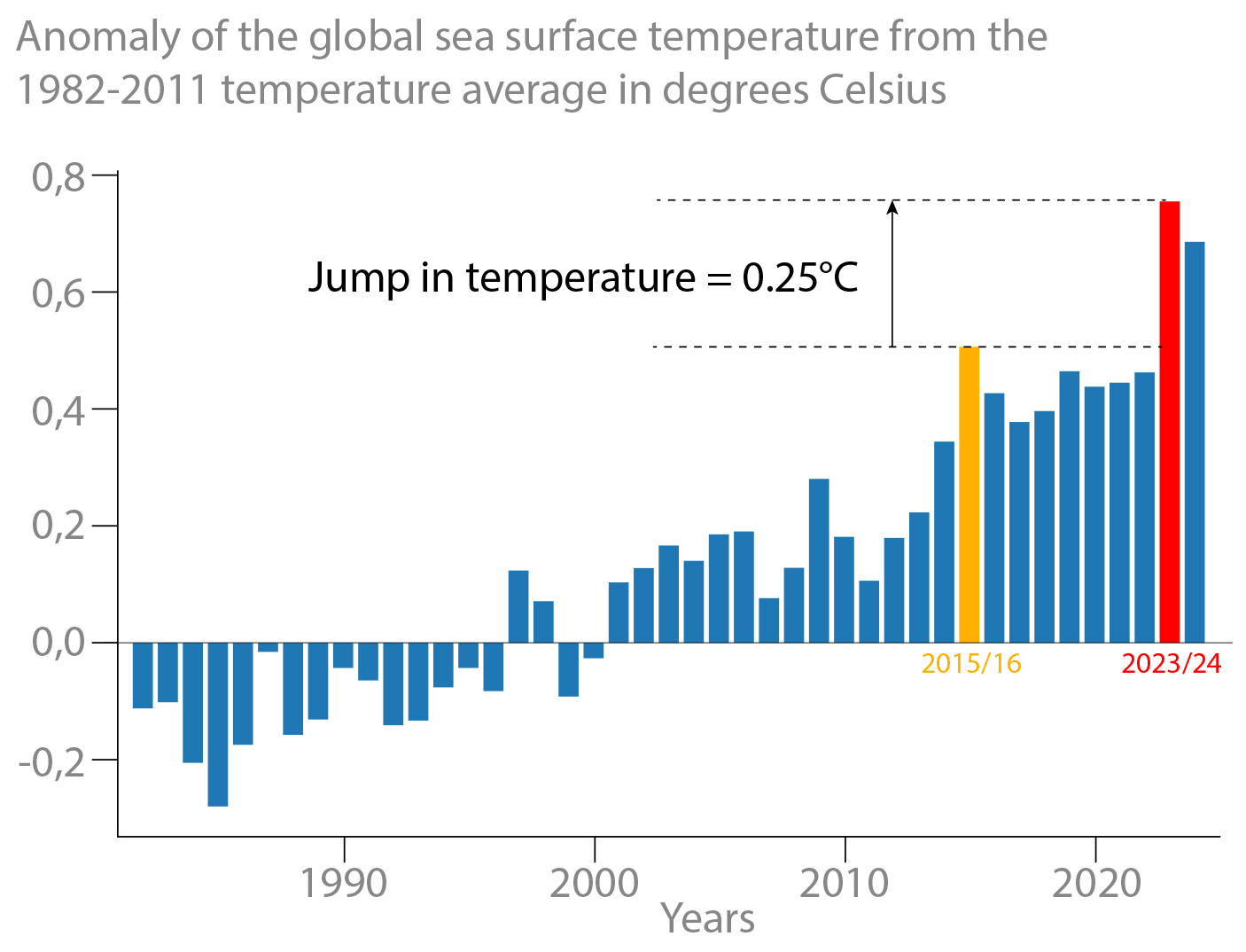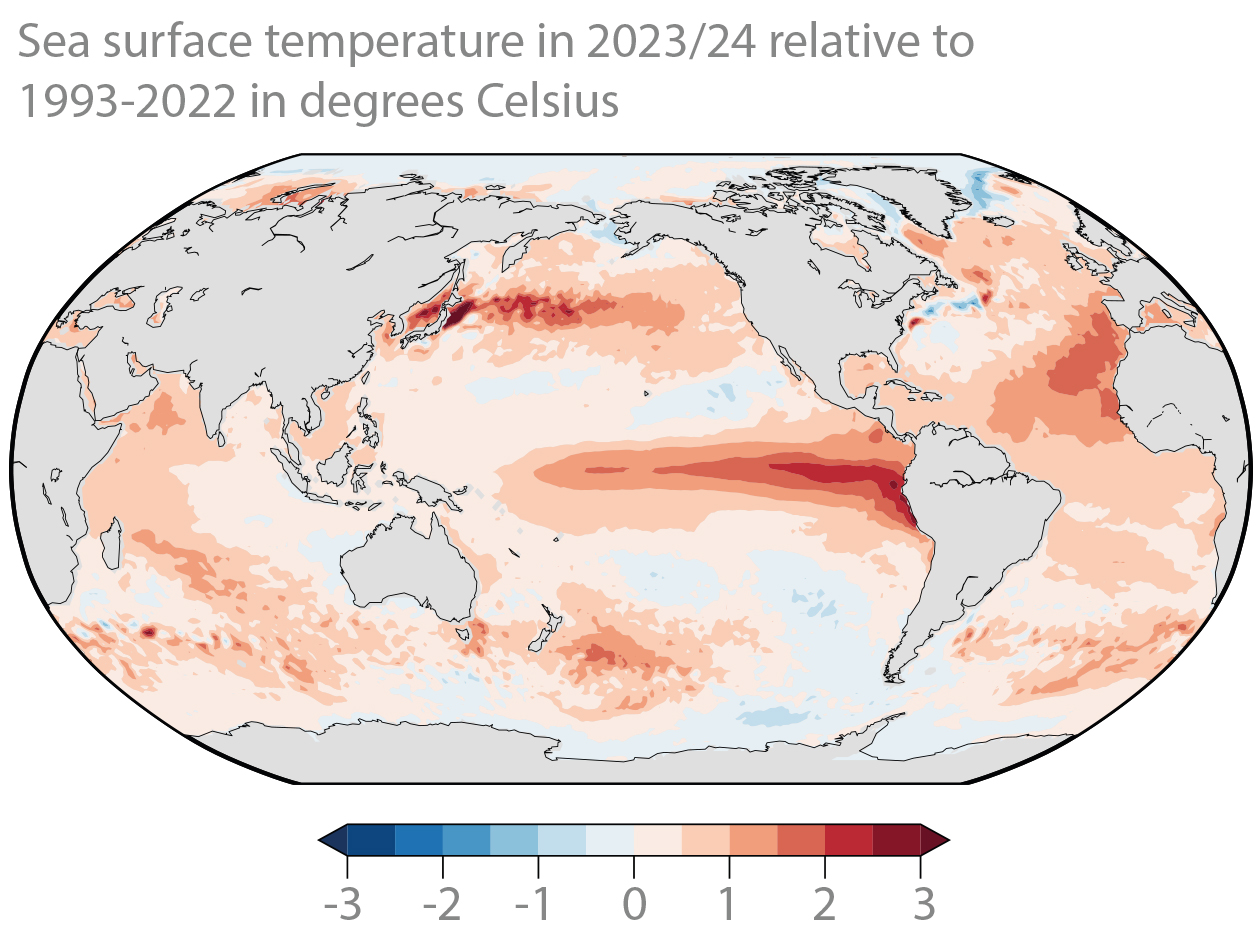Why the ocean temperature has suddenly risen
Two years ago, global sea surface temperatures rose sharply, considerably exceeding previous highs. A study by the University of Bern shows that such extreme temperature jumps would not be possible without the influence of climate change. The study also confirms that climate models simulate such events realistically.
Global sea surface temperatures reached new records between April 2023 and March 2024, exceeding all previous highs by an unprecedented margin of 0.25 degrees Celsius. Many researchers were surprised by the magnitude of the rise in temperatures, as the El Niño phenomenon, which has a warming effect, was not exceptionally strong during these years. Based on this development, researchers suspected that other factors besides climate change and El Niño could play a role, or that climate change is progressing faster and more strongly than previously assumed.
A study led by Dr. Jens Terhaar of the Department of Climate and Environmental Physics at the Physics Institute of the University of Bern now shows that the sharp rise in sea water temperature over the past two years is probably a heatwave that can be fully explained by known global and man-made warming trends and therefore does not necessarily require further influencing factors to explain it. The study was published today in the scientific journal Nature.
Heatwave was only made possible by global warming
The researchers used a combination of observational data, statistical models and climate model simulations to calculate the probability of such temperature jumps. “Our results show that this heatwave is very likely an event that can be expected every 500 years or so under current global warming trends”, says Terhaar, who studies the world’s oceans at the Oeschger Centre for Climate Change Research. “Human-induced global warming is a major contributor to these prevailing climate conditions – without this warming, the event would be virtually impossible.”
The researchers from Bern also show that climate models, which reflect our scientific understanding of the climate system, can realistically simulate the ocean heatwave. “Some researchers feared that the extreme temperature jump is a sign that our understanding of the climate system – and thus our climate models – is incomplete,” says Thomas Frölicher, co-author of the study and professor and deputy chair of the Department of Climate and Environmental Physics at the Physics Institute. This might have meant that other simulations – such as those of future global warming and its consequences – could also be unreliable. However, the researchers were able to find similar jumps in sea surface temperatures in the 35 climate models studied. “The fact that the models correctly simulate the temperature jump confirms our confidence in their use for past and future climate projections,” Frölicher says.
What happens after the rapid rise in temperature?
The climate models are not only able to simulate rapid temperature jumps like those in 2023/24, but have also correctly predicted that temperatures in summer 2024 would no longer be at record levels. According to the climate models, ocean temperatures will not rise faster in the coming years after this extreme event, but just as they were expected to.
The models show that a jump in temperature as rapid as the one in 2023/24 only occurs under El Niño conditions. Researchers had previously proposed other influencing factors to explain the jump in temperature. These include a reduced reflection of warming solar radiation as a result of a reduction in aerosols due to a lower sulfur content in marine fuels. Fewer aerosols can also result in a smaller amount of reflecting clouds, thereby reducing the amount of solar radiation reflected back into space. “We cannot rule out that these factors may have contributed to the temperature jump observed. However, climate models show that the extreme increase is possible without them,” says Dr. Friedrich Burger, co-author of the study and researcher at the Department of Climate and Environmental Physics at the Physics Institute.
Publication details:Jens Terhaar, Friedrich A. Burger, Linus Vogt, Thomas L. Frölicher, Thomas F. Stocker (2025). Record sea surface temperature jump in 2023/24 unlikely but not unexpected, Nature, 12. März 2025. |
Oeschger Centre for Climate Change Research (OCCR)The Oeschger Centre for Climate Change Research (OCCR) is one of the strategic centers of the University of Bern. It brings together researchers from 14 institutes and four faculties. The OCCR conducts interdisciplinary research at the cutting edge of climate science. The Oeschger Centre was founded in 2007 and is named after Hans Oeschger (1927-1998), a pioneer of modern climate research who worked in Bern. |
2025/03/12




